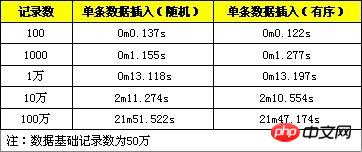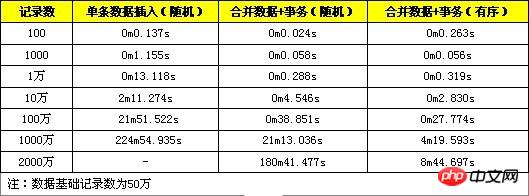 Database
Database
 Mysql Tutorial
Mysql Tutorial
 How to optimize performance? Detailed explanation of examples of MySQL implementing batch insertion to optimize performance
How to optimize performance? Detailed explanation of examples of MySQL implementing batch insertion to optimize performance
How to optimize performance? Detailed explanation of examples of MySQL implementing batch insertion to optimize performance
This article mainly introduces the tutorial of MySQL to implement batch insertion to optimize performance. The running time is given in the article to indicate the comparison after performance optimization. Friends in need can refer to it
For some data with large amounts of data, In large systems, the database faces not only low query efficiency but also long data storage time. Especially for reporting systems, the time spent on data import may last for several hours or more than ten hours every day. Therefore, it makes sense to optimize database insertion performance.
After some performance tests on MySQL innodb, we found some methods that can improve insert efficiency for your reference.
1. One SQL statement inserts multiple pieces of data.
Commonly used insert statements such as
INSERT INTO `insert_table` (`datetime`, `uid`, `content`, `type`) VALUES ('0', 'userid_0', 'content_0', 0); INSERT INTO `insert_table` (`datetime`, `uid`, `content`, `type`) VALUES ('1', 'userid_1', 'content_1', 1);
are modified to:
INSERT INTO `insert_table` (`datetime`, `uid`, `content`, `type`) VALUES ('0', 'userid_0', 'content_0', 0), ('1', 'userid_1', 'content_1', 1);
The modified insert operation can improve the insertion efficiency of the program. The main reason why the second SQL execution efficiency is high here is that the amount of logs after merging (MySQL's binlog and innodb's transaction logs) are reduced, which reduces the amount and frequency of log flushing, thereby improving efficiency. By merging SQL statements, it can also reduce the number of SQL statement parsing and reduce network transmission IO.
Here are some test comparison data, which are to import a single piece of data and convert it into a SQL statement for import, and to test 100, 1,000, and 10,000 data records respectively.

#2. Perform insertion processing in the transaction.
Change the insertion to:
START TRANSACTION; INSERT INTO `insert_table` (`datetime`, `uid`, `content`, `type`) VALUES ('0', 'userid_0', 'content_0', 0); INSERT INTO `insert_table` (`datetime`, `uid`, `content`, `type`) VALUES ('1', 'userid_1', 'content_1', 1); ... COMMIT;

3. Insert data in order.
Orderly insertion of data means that the inserted records are arranged in order on the primary key. For example, datetime is the primary key of the record:
INSERT INTO `insert_table` (`datetime`, `uid`, `content`, `type`) VALUES ('1', 'userid_1', 'content_1', 1); INSERT INTO `insert_table` (`datetime`, `uid`, `content`, `type`) VALUES ('0', 'userid_0', 'content_0', 0); INSERT INTO `insert_table` (`datetime`, `uid`, `content`, `type`) VALUES ('2', 'userid_2', 'content_2',2);
is modified to:
INSERT INTO `insert_table` (`datetime`, `uid`, `content`, `type`)
VALUES ('0', 'userid_0', 'content_0', 0);
INSERT INTO `insert_table` (`datetime`, `uid`, `content`, `type`)
VALUES ('1', 'userid_1', 'content_1', 1);
INSERT INTO `insert_table` (`datetime`, `uid`, `content`, `type`)
VALUES ('2', 'userid_2', 'content_2',2);Since the database needs to maintain index data when inserting, disordered records will increase the cost of maintaining the index. We can refer to the B+tree index used by innodb. If each inserted record is at the end of the index, the index positioning efficiency is very high, and the index adjustment is small; if the inserted record is in the middle of the index, B+tree is required. Processes such as splitting and merging will consume more computing resources, and the index positioning efficiency of inserted records will decrease. When the amount of data is large, there will be frequent disk operations.
The following provides a performance comparison of random data and sequential data, which are recorded as 100, 1000, 10000, 100000 and 1 million respectively.

#From the test results, the performance of this optimization method has improved, but the improvement is not very obvious.
Comprehensive performance test:
Here is a test that uses the above three methods to optimize INSERT efficiency.

It can be seen from the test results that the performance improvement of the method of merging data + transactions is obvious when the amount of data is small. When the amount of data is large, the performance improvement is obvious. (more than 10 million), the performance will drop sharply. This is because the amount of data exceeds the capacity of innodb_buffer at this time. Each index positioning involves more disk read and write operations, and the performance drops quickly. The method of using merged data + transactions + ordered data still performs well when the data volume reaches tens of millions. When the data volume is large, the ordered data index positioning is more convenient and does not require frequent read and write operations on the disk. Therefore, high performance can be maintained.
Notes:
1. SQL statements have a length limit. When merging data in the same SQL, the SQL length limit must not be exceeded. It can be modified through the max_allowed_packet configuration. The default is 1M, modified to 8M during testing.
2. Transactions need to be controlled in size. If a transaction is too large, it may affect execution efficiency. MySQL has the innodb_log_buffer_size configuration item. If this value is exceeded, the innodb data will be flushed to the disk. At this time, the efficiency will decrease. So a better approach is to commit the transaction before the data reaches this value.
The above is the detailed content of How to optimize performance? Detailed explanation of examples of MySQL implementing batch insertion to optimize performance. For more information, please follow other related articles on the PHP Chinese website!

Hot AI Tools

Undresser.AI Undress
AI-powered app for creating realistic nude photos

AI Clothes Remover
Online AI tool for removing clothes from photos.

Undress AI Tool
Undress images for free

Clothoff.io
AI clothes remover

AI Hentai Generator
Generate AI Hentai for free.

Hot Article

Hot Tools

Notepad++7.3.1
Easy-to-use and free code editor

SublimeText3 Chinese version
Chinese version, very easy to use

Zend Studio 13.0.1
Powerful PHP integrated development environment

Dreamweaver CS6
Visual web development tools

SublimeText3 Mac version
God-level code editing software (SublimeText3)

Hot Topics
 PHP's big data structure processing skills
May 08, 2024 am 10:24 AM
PHP's big data structure processing skills
May 08, 2024 am 10:24 AM
Big data structure processing skills: Chunking: Break down the data set and process it in chunks to reduce memory consumption. Generator: Generate data items one by one without loading the entire data set, suitable for unlimited data sets. Streaming: Read files or query results line by line, suitable for large files or remote data. External storage: For very large data sets, store the data in a database or NoSQL.
 How to use MySQL backup and restore in PHP?
Jun 03, 2024 pm 12:19 PM
How to use MySQL backup and restore in PHP?
Jun 03, 2024 pm 12:19 PM
Backing up and restoring a MySQL database in PHP can be achieved by following these steps: Back up the database: Use the mysqldump command to dump the database into a SQL file. Restore database: Use the mysql command to restore the database from SQL files.
 How to optimize MySQL query performance in PHP?
Jun 03, 2024 pm 08:11 PM
How to optimize MySQL query performance in PHP?
Jun 03, 2024 pm 08:11 PM
MySQL query performance can be optimized by building indexes that reduce lookup time from linear complexity to logarithmic complexity. Use PreparedStatements to prevent SQL injection and improve query performance. Limit query results and reduce the amount of data processed by the server. Optimize join queries, including using appropriate join types, creating indexes, and considering using subqueries. Analyze queries to identify bottlenecks; use caching to reduce database load; optimize PHP code to minimize overhead.
 How to insert data into a MySQL table using PHP?
Jun 02, 2024 pm 02:26 PM
How to insert data into a MySQL table using PHP?
Jun 02, 2024 pm 02:26 PM
How to insert data into MySQL table? Connect to the database: Use mysqli to establish a connection to the database. Prepare the SQL query: Write an INSERT statement to specify the columns and values to be inserted. Execute query: Use the query() method to execute the insertion query. If successful, a confirmation message will be output.
 How to create a MySQL table using PHP?
Jun 04, 2024 pm 01:57 PM
How to create a MySQL table using PHP?
Jun 04, 2024 pm 01:57 PM
Creating a MySQL table using PHP requires the following steps: Connect to the database. Create the database if it does not exist. Select a database. Create table. Execute the query. Close the connection.
 How to use MySQL stored procedures in PHP?
Jun 02, 2024 pm 02:13 PM
How to use MySQL stored procedures in PHP?
Jun 02, 2024 pm 02:13 PM
To use MySQL stored procedures in PHP: Use PDO or the MySQLi extension to connect to a MySQL database. Prepare the statement to call the stored procedure. Execute the stored procedure. Process the result set (if the stored procedure returns results). Close the database connection.
 How to fix mysql_native_password not loaded errors on MySQL 8.4
Dec 09, 2024 am 11:42 AM
How to fix mysql_native_password not loaded errors on MySQL 8.4
Dec 09, 2024 am 11:42 AM
One of the major changes introduced in MySQL 8.4 (the latest LTS release as of 2024) is that the "MySQL Native Password" plugin is no longer enabled by default. Further, MySQL 9.0 removes this plugin completely. This change affects PHP and other app
 The difference between oracle database and mysql
May 10, 2024 am 01:54 AM
The difference between oracle database and mysql
May 10, 2024 am 01:54 AM
Oracle database and MySQL are both databases based on the relational model, but Oracle is superior in terms of compatibility, scalability, data types and security; while MySQL focuses on speed and flexibility and is more suitable for small to medium-sized data sets. . ① Oracle provides a wide range of data types, ② provides advanced security features, ③ is suitable for enterprise-level applications; ① MySQL supports NoSQL data types, ② has fewer security measures, and ③ is suitable for small to medium-sized applications.





